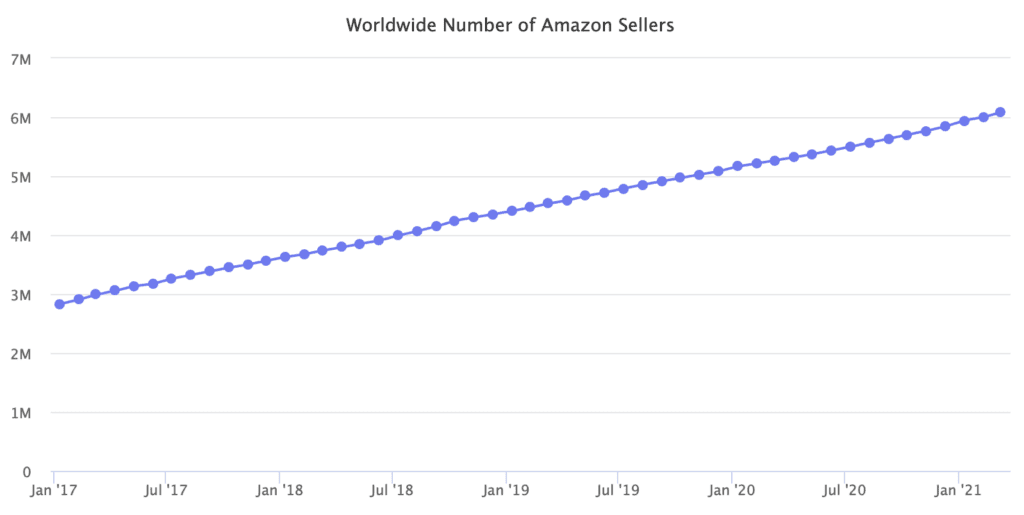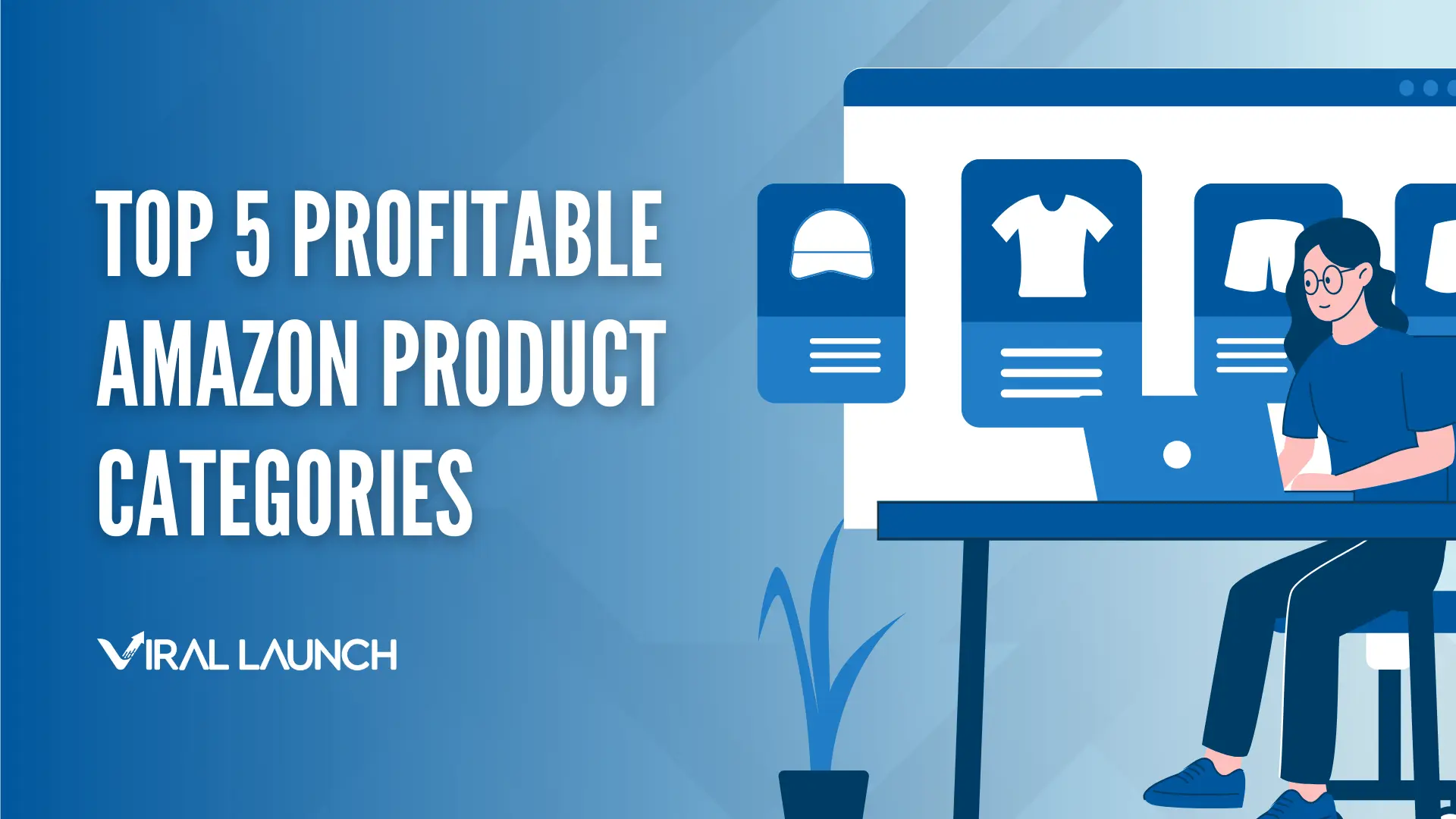When it comes to thriving in the competitive world of eCommerce, selling on Amazon remains one of the most lucrative avenues, especially for experienced sellers. The question that every seller faces at some point or another is: How to find products to sell on Amazon?
According to Marketplace Pulse research, there are currently over 6.3 million third-party sellers on Amazon, with over 50% of them selling on Amazon in North America. This statistic highlights the fierce competition among Amazon sellers and the need for advanced product research strategies to stay ahead.
This guide will dive deep into some of the most effective and advanced Amazon product research strategies. Experienced sellers can leverage these strategies to gain the competitive edge they need to make their desired sales.
Overview of Advanced Amazon Product Research Strategies
What is advanced Amazon product research?
When it comes to selling on Amazon, there are a few secrets you need to know to succeed, and one of them is knowing how to find products to sell on Amazon.
Product research involves all the processes used to identify profitable product opportunities. Analyzing key metrics such as market trends, demand, and competition are pivotal to this process.
According to Jim Pendergast, Senior Vice President at altLINE Sobanco, “Experienced sellers may need to dig deeper and go beyond the basic Amazon product research techniques that everyone is already using. That’s where the magic of advanced Amazon product research comes into the picture.”
Advanced Amazon product research goes beyond just scratching the surface. It involves a more in-depth approach to identifying the most profitable and less competitive product opportunities on Amazon. You can remove the guess work from your product research using an Amazon product research tool and other techniques to analyze data, uncover hidden trends, and make data-driven decisions.
Advanced Amazon product research may require that you invest a significant amount of your time and effort. However, you can be sure that it will pay off handsomely in terms of increased sales and revenue.
Importance of advanced Amazon product research
There are many reasons why sellers on Amazon should be intensely interested in conducting product research and leveling up their strategies.
First, it lets you identify and explore potentially profitable opportunities and niches. Amazon product research can aid you in identifying gaps in the market and finding the perfect product categories – those in high demand but with low competition. This will set you apart from the crowd and help sky-rocket your sales.
Furthermore, Amazon product research can provide you with a head-start by aiding in evaluating and assessing competitors and the potential lucrativeness of a product before committing your time and money to it. This can save you money, as it can prevent you from investing in goods that won’t assist you in reaching your financial targets.
Knowing how to find products to sell on Amazon using an Amazon product research tool and advanced product research techniques can help you refine your product descriptions for search engines and improve your product’s visibility in search results.
Once you possess a robust knowledge of the key terms clients are searching for, you can devise superior titles, descriptions, and tags for your products. This will facilitate your products to appear higher in the search results, ultimately increasing their visibility and the likelihood of generating more revenue.
Advanced Amazon product research techniques
Having recognized the significance of Amazon product research, the subsequent step entails examining the methods for executing and leveling these methods up. A few of these include the following:
• Reverse Engineering:
It entails carefully scrutinizing the best-selling products in a specific market segment and disassembling their attributes, constituents, and pricing to construct a comparable or superior product.
Reverse engineering can provide you with invaluable insights into what constitutes a specific product’s success. Subsequently, you can apply this knowledge to design a product that surpasses your competitors.
• Bundling:
It involves grouping related products and selling them at a reduced cost. This approach can be highly effective since it enhances the assessed value of the product and stimulates customers to purchase multiple items at once, increasing the seller’s earnings.
• Keyword research:
When customers visit Amazon to explore products, they enter keywords or phrases pertaining to their desired purchase.
By conducting thorough keyword research, you can discover high-traffic search terms that can increase your product’s visibility to prospective customers. This tactic can enhance the likelihood of attracting customers to your product when they conduct a search.
• Identifying and analyzing competitor products and listings:
Acquiring a comprehensive understanding of the competitive landscape and identifying effective strategies to differentiate your offerings is a crucial step. By evaluating the offerings of your competitors, you can identify opportunities to improve your existing products and establish unique selling points that set your products apart.
• Finding unique or custom products to sell:
There exist numerous products that are not commonly available on Amazon or that can be personalized to meet the specific requirements of clients. If you can find such unique or bespoke products, you will achieve a competitive edge and entice niche markets that might not be adequately served by existing products.
These strategies, when applied effectively, can lead to a significant increase in sales and profits and, ultimately, success on Amazon.
However, it is noteworthy that the online shopping landscape continuously changes, and what was effective in the past may not inevitably be fruitful today. Therefore, you must remain updated on the most recent product research trends and tools, including how to find products to sell on Amazon, to facilitate expanding your business on Amazon.
Identifying and analyzing competitor products and listings
Techniques for identifying and analyzing competitor products and listings
When selling on Amazon, one of the most critical factors determining your success is how well you understand your competition. Taking time to identify and analyze your competitor’s products and listings will help you locate loopholes you can capitalize on to stand out from the crowd.
Below are some proven methods of identifying and analyzing your competitors on Amazon.
• Conduct keyword research:
Look up keywords and phrases related to your product or niche on Amazon.
Anthony Martin, Founder and CEO of Choice Mutual, adds, “Go through the top results and analyze the listings to see what your competitors are doing – what they are selling, how they are positioning their products, and the specific keywords they are targeting.”
• Use Amazon’s “Customers who bought this also bought” feature:
Many sellers on Amazon still don’t know how useful this feature is in helping to identify related products that their customers are also interested in. You must analyze these products to see if your competitors offer them.
• Utilize Amazon’s “Sponsored Products” ads:
These appear on Amazon’s search results page and are a great way to identify and track your competitors. Study these ads to find out what products your competitors are promoting and what keywords they are targeting.
• Analyze your competitor’s product reviews:
Knowing what customers think about your competitor’s products is invaluable when selling on Amazon. Such reviews may provide detailed insights into consumers’ preferences, empowering you to utilize this data to enhance your product offerings.
Having made significant progress in recognizing your competitors, the next phase involves analyzing their product listings. Here are some crucial elements that you should pay attention to:
• Product title:
In this case, it’s crucial to take a few hints from how your competitors are naming their products. Are they utilizing brief or lengthy titles? Are they integrating their brand name? Or are there any other descriptive terms they are utilizing? Answering these questions will aid you in devising your unique and appealing product title.
• Product Description:
Your product description is the perfect avenue to exhibit and highlight your product’s distinctive characteristics and advantages. You can analyze the product descriptions of your competitors and explore methods to distinguish your products from theirs.
• Images:
To draw the interest of potential buyers swiftly on Amazon result pages, deploying catchy images is crucial. One of the most effective techniques to accomplish this is utilizing exceptional-quality images. It is necessary to look at the images used by your competitors to present their products, compare them with yours, and ascertain if there is room for improvement.
Make an effort to identify and analyze the products and listings of your competitors. You will obtain precious insights that reveal how to find products to sell on Amazon efficiently, including what’s effective in your niche, and give you ideas for enhancing your offerings.
Finding unique or custom products to sell
Strategies for identifying and sourcing unique or custom products
Eric Mills, Owner of Lightning Card Collection, says, “As a novice seller on Amazon, it is essential to steer clear of selling products already excessively saturated with competition. This will help you to minimize the risk of being overshadowed by the already established market players.”
To stand out among the multitude of other Amazon sellers and draw in shoppers searching for something distinct, exclusive, or personalized, it is advisable to discover a means of distinguishing yourself. An excellent approach to achieving this is by finding unique or bespoke items to sell.
However, recognizing and procuring these unique products that can put you ahead of the competition may present a challenge. Below are some suggestions that can steer you in the right direction as you embark on your quest to discover one-of-a-kind or personalized products to sell on Amazon:
• Search for handmade products:
Handmade products hold a significant spot in the hearts of numerous buyers, and these consumers are usually prepared to pay a higher price for them. Websites like Etsy, a platform for vintage and handmade items, offer a wide range of handmade products. Additionally, it’s a good idea to prioritize visiting craft fairs and exhibitions to discover artisans who produce one-of-a-kind products.
• Consider private label products:
Not sure what private label products are? Don’t fret. They are products you don’t manufacture yourself but can be sold under your brand name. After receiving the product, all you have to do is customize it to your taste and make it appealing to customers.
This strategy can be very effective, primarily when you identify a currently trending product with few customization options.
• Take advantage of online marketplaces:
There are so many online marketplaces, such as DHgate, where you can find reliable suppliers specializing in custom or unique products.
You can ask these suppliers if they offer a range of customization options. Options, such as different colors, sizes, or materials, so you can be creative and bring your unique product to life.
• Work with a designer:
If you have a specific idea in mind for a unique product but need to know how to put the pieces together, you can employ the services of a designer to create a custom design.
Where to find designers? Easy! You can go on sites such as Upwork and Fiverr or attend design conferences and events to network and collaborate with designers in person.
You need to be ready to explore new opportunities and put your creativity to use when trying to learn how to find products to sell on Amazon. These unique products might just be what you need to take your sales game to the next level!
Tips for finding and working with suppliers for custom products
Identifying unique source products can be overwhelming, particularly if you lack experience collaborating with suppliers. Here are some pointers to facilitate and streamline the process of discovering and engaging with manufacturers of bespoke items:
• Know your product requirements:
Before commencing your search for suppliers, it is vital to carry out research. Have a distinct understanding of your product requirements, including the type of material, dimensions, and design you desire.
A clearly outlined product specification will make explaining to potential suppliers what you are looking for easier and ensure you get the exact product you want.
• Check supplier credentials:
When encountering a potential supplier, look at their credentials. It’s imperative to find a supplier with substantial expertise in dealing with your category of merchandise and a favorable reputation in the industry.
• Request samples:
To discover the appropriate supplier, demand samples of products from potential suppliers. This will grant you a glimpse into the quality of their work. Asking for samples should assist you in determining whether you intend to proceed and collaborate with the supplier.
• Negotiate prices:
While collaborating with suppliers, it is crucial to ensure that you negotiate cost-effectively to secure the best deal. Disclose your budget and expectations transparently, and do not be reluctant to negotiate a deal that is favorable to you.
Conclusion
In the world of e-commerce, the competition is intense. Only the most seasoned sellers who implement advanced product research techniques will prosper.
Although traditional product research strategies are still utilized, they possess limitations, and sellers who exclusively rely on them are likely to miss numerous opportunities.
Performing advanced product research requires time, energy, and resources. Sellers must allocate resources to reliable tools and stay current with the most recent advancements to make more informed decisions.
By implementing the strategies detailed in this guide and continuously refining their tactics, sellers will know how to find products to sell on Amazon, maintain a competitive edge, and establish themselves for long-term success in Amazon’s marketplace.








